Sunday, October 29, 2006
What do you want me to do for you?
This seemingly simple story about the healing of Timaeus, a blind beggar who regains his sight, is actually a very sophisticated literary and theological construct. Mark has carefully placed this story at a critical juncture in his narrative, between the account of Jesus’ ministry in Galilee and the account of Jesus’ arrest, trial, torture, and execution in Jerusalem. We must pay careful attention to the location of this story in the overall context of Mark’s gospel if we are to understand it properly.
The healing of Timaeus sets up a series of contrasts that serve to illustrate what it means to follow Jesus “on the way.” This healing story concludes a significant section of Mark’s gospel that began in chapter 8 with the healing of another blind man. These two stories about “sight” bracket and underscore a series of stories that reveal the “blindness” of the disciples. The disciples repeatedly fail to understand Jesus’ identity and mission. They refuse to accept his predictions of his death and resurrection. They misconstrue his practice of healing, hospitality, and service, still consumed as they are with their own hunger for power, prestige and status.
The disciples, especially Peter, James, and John, assume that they are privileged members of his inner circle. Not unlike some Christians in our own day, they believe that following Jesus guarantees worldly success and reinforces their sense of entitlement. They hope to ride his coattails to power and, in so doing, reveal how blind they are to the truth of the life he lived and the reality of the death he would face.
How ironic then that Timaeus, a blind beggar, a “nobody,” demonstrates a far greater capacity to “see” than Peter, James, or John. Jesus calls Timaeus, just as he called the disciples, responding to his insistent and persistent cry. By his faith, Timaeus was able to truly “see” Jesus. By faith he regained his sight and followed him on the way. It is this outsider who really “gets it,” while the insiders remain blind.
Remember Jesus’ words to James and John when they were jockeying to position themselves as his right (and left) hand men: “For the Son of Man came not to be served but to serve, and to give his life a ransom for many.” In his usual reversal of the order of things, Jesus tells us plainly that he has come to stand in solidarity with those who are in bondage, to offer his life in payment for their freedom. The Son of Man, the fully Human One, comes to give his life so that others may have life.
Timaeus, which literally means “one who was purchased or bought,”[1] sees Jesus clearly and follows him willingly because he knows that he is one of the many whom Jesus has purchased from slavery. He has been ransomed, set free from degradation and oppression, by the mercy of God in Jesus. Peter, James, and John represent those who are unwilling to accept their vulnerability, their need for God’s mercy. They remain blind to their true condition and to the compassionate way of Jesus. Timaeus, in contrast, knows who he is – one whose freedom has been secured by an Other – and sees clearly that Jesus, the Compassionate One, was willing to pay the price for that freedom.
By following Jesus “on the way,” Timaeus truly becomes his disciple; one who in turn is willing to give his life over to compassionate service so that others might be set free. And so we have these sharp contrasts: between the sighted disciples who are really blind, and the blind beggar who really sees; between the disciples who think their inner-circle status is secured by their own merit, and the blind beggar who knows that his freedom, his dignity, is based on the mercy of the Compassionate One.
There is yet one more contrast for us to ponder in this story, one that moves us from the text to its wider cultural context. Any reader of Mark’s Gospel in the early Church would have immediately recognized Timaeus as the philosopher and protagonist after whom Plato’s great dialogue is named. Plato’s Timaeus was the most widely read Greek work in antiquity after Homer, and has had the longest continuous influence in the West of any of Plato’s dialogues. It is, perhaps, no accident, that Mark should name this blind beggar, Timaeus.
In fact, Mark’s blind Timaeus, appearing as he does at the juncture between the two main sections of his Gospel, calls to mind a speech of Plato’s Timaeus that occurs at the juncture between the two main sections of his dialogue, and which also takes up the metaphor of sight:
The sight in my opinion, says Plato’s Timaeus, is the source of the greatest benefit to us, for had we not seen the stars and the sun and the heaven, none of the words which we have spoken about the universe would ever have been uttered. But now the sight of day and night, and the months and the revolutions of the years have created number and have given us a conception of time. And from this source we have derived philosophy, than which no greater good ever was or will be given by the gods to mortal man. This is the great boon of sight, and of the lesser benefits why should I speak? Even the ordinary man if he were deprived of them would bewail his loss, but in vain. This much let me say however. God invented and gave us sight to the end that we might behold the courses of intelligence in the heaven, and apply them to the courses of our own intelligence . . . and that we, learning them and partaking of the natural truth of reason, might imitate the absolutely unerring courses of God and regulate our own vagaries.
As Gordon Lathrop notes, the “ordinary man” of Plato’s Timaeus is literally in the Greek text a “blind man,” unable to attain to the heights of vision accessible only to the philosopher.[2] There is more than a hint of disdain here for the ordinary person, who is unable to attain the good life due to his or her limited capacity to imitate God by exercising the power of reason. Plato’s Timaeus ignores the wailing of the blind man, the ordinary person, who has nothing to contribute to the philosopher’s project. In the cosmology of the Timaeus, there is no room for compassion, no recognition of our need for divine mercy.
Thus Mark is engaged in an imitation and reversal of Plato’s Timaeus. According to Mark, it is Timaeus who is blind, of no account, incapable of seeing the world rightly. It is only as he becomes willing to acknowledge his blindness and accept his need for healing that his vision is restored. And unlike Plato’s Timaeus, Jesus refuses to ignore the wailing of the blind person who desires to see. In this story, Mark develops a final and telling contrast between the worldview of Jesus, the Son of David, the servant Rabbi whose compassion brings true vision, and the worldview of Plato, the Son of Timaeus, the privileged philosopher blind to the suffering of humanity, the dignity of ordinary people, whose blindness can only be healed by recognizing his need for God’s mercy.
The blindness that afflicts us is our blindness to human suffering and to our complicity in that suffering. The remedy is the practice of compassion. This spiritual blindness is universal, according to Mark: it afflicts both Jew and Gentile, Christian disciple and pagan philosopher. Its root cause is our tendency to make invidious distinctions between insiders and outsiders, the pure and impure, the worthy haves and the unworthy have-nots. Whether we are the disciples trying to tell the blind beggar to shut up and leave Jesus alone, or the arrogant philosopher simply ignoring him as if he were invisible, or the blind one who refuses the mercy offered us, we are all blind until we are willing to follow Jesus on the way of compassion.
We will not be saved by our insider states, by our purity, or by our success. We will not be saved by science, or technology, or human reason, which frequently turn a blind eye to the reality of suffering that they themselves create and legitimate. We will not, alas, be saved by religion or religious observances either. We will be saved by accepting the mercy of God and sharing it with others. That is how Timaeus regained his sight. Jesus invites us to be made well by a similar act of faith and then follow him on the way.
In this regard, I think our bishop, Marc, wisely reminds us that authentic communion, Christian or otherwise, is a union of persons with each other and with God, who are committed to the healing of global human suffering and the mending of the earth that sustains us. If we wish to follow Jesus, then we must cultivate compassion as the cure to our spiritual blindness, and become engaged in the work of healing and mending.
What we discover as we follow Jesus on the way is that this work, far from being drudgery or depressing, is the source of great joy, because through it we come to be in touch with the very life and love of God. As a congregation, I believe we will come to experience such joy as we continue to cultivate a relationship of mutual, loving service with Mission San Lucas in El Salvador. I believe, too, that we must develop a similar project locally, so that we can share the joyful work of compassionate service with our neighbors near at hand. Here is a great mystery: it is in healing that we are healed. It is in giving that we receive. It is by dying that we are raised up into life. It is in acknowledging our blindness, that we become able to see.
We are afflicted with spiritual blindness, yes. But the remedy is at hand. This morning, Jesus asks us, “What do you want me to do for you?” May we have the courage to reply, “My teacher, let me see again.” Amen.
[1] See Theodore Jennings, Jr., The Insurrection of the Crucified: The “Gospel of Mark” as Theological Manifesto, pp. 174-175 for his discussion of this passage.
[2] Gordon Lathrop, Holy Ground: A Liturgical Cosmology, pp. 25-32. The quote from The Timaeus is on p. 28 of Lathrop’s text.
Baptism and Asbestos Wear
The guidelines recommend baptizing the adopted children of same-sex couples, as long as the children will be raised as Catholics. It says that gay people may benefit from revealing their “tendencies” to friends, family and their priest, but should not make “general public announcements” about it in the parish.
The guidelines also say that gay men and lesbians have “no moral obligation to attempt” therapy, an apparent reference to therapy programs that claim to change gay people’s sexual orientation. It says that while “some have found therapy helpful,” there is “no scientific consensus” either on therapy or the causes of homosexuality . . .
“The bishops would like people with homosexual inclinations to really participate in the church, but they don’t want to ‘give scandal,’ ” Father Weinandy said. “If you knew a heterosexual couple were just cohabitating and not married, you wouldn’t let them be eucharistic ministers either.”
Of course, gay and lesbian people are denied access to sacramental marriage, as well as civil marriage (except for Massachusetts), so it seems unfair to compare them to cohabitating heterosexuals. It entirely begs the question of whether legal marriage is the only form in which sexual union can become a path to holiness, but that is another kettle of fish.
It sounds to me like the bishops are not of one mind, trying to simultaneously condemn and reach out to gay and lesbian Roman Catholics. It is a classic double bind: "We welcome you; we are ashamed of you. Take part in the church; remain invisible." I think I prefer to be condemned outright. This smacks of being welcomed for my money and energy, so long as I check my dignity at the door. Unfortunately, this view represents the attitude of far too many Anglican bishops too.
Warning to gay and lesbian folks: make sure you put on your asbestos wear for your baptism. You'll need it.
James Alison provides the best response to the Church's binding of the gay conscience that I have seen in print. His writing is a wonderful antidote to the ecclesial poison meted out to gay and lesbian folks. Get your prescription filled soon!
Saturday, October 28, 2006
Sex Thoughts
"As with thought about food, my interior thoughts about sexual intimacy can dominate the whole of my consciousness. These thoughts freeze me in endless thinking. Not only can I not love God with my whole mind, body, and soul, but I cannot love anyone else either. My thoughts get turned back to myself over and over again. The loop goes nowhere and locks the ego to the self. If I am looking for a mate in each person who walks through the door,or if I am preoccupied with the thought of getting my sexual longings satisfied, spiritual awareness is dim. The interior life is about union with God and being in service to others. Sexual urges pull me back to self-reflexiveness. The ego is served, the self is dominant, and we are busy working for gain. Ultimately this kind of interior agenda is unsuitable for the spiritual life. The false self is shored up once again. Sex is good, but like food it can consume me rather than nourish my body, mind, and soul."
Sex is good, but powerful. It must be handled with care or it can overwhelm and even destroy us. The first step is to become conscious of our sexual thoughts and inclinations so that we can make decisions about them. Do we have sexual thoughts or do they "have" us? Awareness is the first step toward freedom in this aspect of our spiritual life.
Here we must come to terms with some basic issues. Clarity about one's heterosexual or homosexual orientation is important and can be discerned by "honestly facing the inner object of one's own fantasy." Then one must become clear about one's vocation or calling in life, and how sexuality is to be integrated into that lifestyle. Notice that the goal is not to suppress or deny our sexuality, but to make conscious choices about it in relationship to our chief end as human beings: unending communion with God through Christ.
Here a few distinctions are in order. Continence, refraining from sexual activity, is often dictated by life circumstances: a partner's death, extended illness, or pregnancy. It is a matter of refraining from sex for whatever reason. This can be helpful in getting clarity about our own sexual thoughts so that we can discern how we are called to integrate our sexuality into our life and ministry.
Celibacy is a monastic promise to remain continent, not because sex or sexual thoughts per se are bad, but in order to consciously sublimate them in service to the love of God and neighbor. This actually requires a sophisticated level of awareness and continuous turning-over to God of one's sexual thoughts. It is not a matter of sexual avoidance or suppression. The goal is chastity, or purity of heart with respect to sexual thoughts so that the mind is focused on God alone.
Marriage is a promise to be sexual exclusively with one other person. The path of sexual union then becomes a means of cultivating sexual awareness and practice in the service to the love of God and neighbor, beginning with the beloved and extending to a deeper capacity to love others as well. Sr. Meg, perhaps due to her own monastic promises, seems less clear about the spiritual practice, indeed the sacramentality, of sexual union. In fact, she implicitly treats it is a lesser spiritual state that we all outgrow eventually, analogous to the traditional Hindu practice of moving through the stages of student, householder (marriage), hermit (retired person), and ascetic. In the end, are we really all meant to be a monk or nun?
I would disagree with her that celibacy is necessarily the form of integrated sexuality most conducive to contemplative practice. The conjugal way, the practice of sexual union, can become an expression of self-giving love for the sake of the beloved rather than mere selfish gratification. It can become a symbol of our participation in the Paschal Mystery, the very mystery of God's self-giving in Christ for our sake. However, I think she is right that whether celibate, married, or single, gay or straight, it takes serious spiritual effort to integrate sexuality into our contemplation of God.
Perhaps Funk's best counsel is her recovery of the practical advice of the desert mothers and fathers for dealing with compulsive sexual thoughts. One consistent aspect of this counsel is a willingness to ask for help. We cannot make progress in this area by ourselves. Thus, we are admonished to pray God for help (most thoughts or feelings diminish in intensity after about 5 minutes), or to exercise, read, or engage in some other healthy endeavor with the intention of turning over troubling thoughts to God.
Funk also recalls the desert mothers and fathers' practice of exagoreusis or manifestation of thoughts to a trusted elder spiritual father or mother. "The monastic would manifest his interior thoughts in an external forum, to his abbot. No analysis. No storytelling. Just laying out the thought in a safe, sacred space: 'Dash your thought against a rock.' The abbot or an elder would listen with a discerning heart." Moreover, the trusted elder would offer a word that would break open one's heart and release the source of the compulsion. The point of the exercise is freedom.
"Chastity is heart work. One of the fruits of a chaste life is to be innocent. My soul is open and my heart is not divided. No secrets, no inner desires are kept from God or my spiritual director. No duplicity exists in me. I am naked to myself, to God (and to my spouse, if married) and what others see is what they can trust to be really so. The heart is at peace. The fruit of a chaste life is to seek God right now, right here because the self is wholly present. Awareness leads to insight and creative energy."
Wednesday, October 25, 2006
Food Thoughts
She begins with the basic, instinctual impulse for food and drink. The first step in mental training is to become aware of how frequently we think of eating and drinking and the choices this leads us to make. Here, fasting can be of enormous help. Following John Cassian, Funk interprets fasting as putting food and our thoughts about food into healthy balance; for example avoiding eating between meals. Eat food that is local, seasonal, nutritional and well-portioned. Eat at set times that allow one to be focused on the practice of meal prepration and consumption. Eat with others as an act of hospitality.
The action of eating and drinking is an expression of our interior life. Are we compulsive, fearful, or insecure? Are we mindful and generous, or scattered and selfish? Are we greedy or grateful? These inner dispositions rooted in our thoughts are readily seen in our table practice. The renunciation of thoughts about food and drink is about moderation. "The value of moderation is that extremes do not become another thought and eventually more intrusive than the original thought of food . . . My thinking patterns are checked by my fasting practice, that is, eating at the appointed time, eating what is served and not desiring an inappropriate quality of food."
"The first struggle with food and drink is a wonderful place for beginners to start, even though we are all beginners; it takes a lifetime to develop disciplines into patterned lifestyles. The lessening of the grip of the thought of food and of drink eventually provides the opportunity for other levels of consciousness to emerge. This is why food and drink addiction are so harmful to the interior life. The seeker learns to resist thoughts, desires, and passions that return only to the self. The goal is to love God and be for others." I would add that this is also why global hunger is so dehumanizing: it stunts spritual as well as physical development.
Funk goes on to examine various precepts for ethical eating and drinking, including a caution against judging others in these matters. She concludes by saying, "Food should not dominate my consciousness; it is only a tool for my relationship with God. But on the other hand food should not be a barrier to keep me from deeper stillness and a predisposition toward prayer [e.g. hunger and malnutrition]. A fruit of the contemplative life is the joy of eating mindfully with gratitude."
I can only add that this is also a fruit of our Eucharistic practice. The sharing of Holy Communion is also a practice of eating and drinking with mindfulness and thanksgiving. When we are aware and grateful, we can then become the bread that is broken open to be shared with others so that they, too, might enjoy the feast.
Tuesday, October 24, 2006
Thoughts Matter
The first is the renunciation of our former way of life so that we might move closer to our hearts true desire: unimpeded communion with God. Often referred to as conversion, repentance, or change of heart, it is basically about reordering our exterior life to facilitate deep soul work. It is about making the necessary changes in our daily life so that we can get past the "automatic chatter of unconscious living" as Funk puts it.
The focus of this book, however, is upon the second renunciation: the renunciation of thoughts and our attachment to thoughts so that we might engage in unceasing prayer. Here, Funk explores the traditional order of mental preoccupations that undermine such prayer: food, sex, things, anger, dejection, acedia (spiritual listlessness), vainglory (taking credit for what God has done), and pride. These are listed in order of increasing complexity. We must renounce them to attain purity of heart and the peace that flows from it.
The third and final renunciation, is to renounce our very idea of God so that we can love God truly as God is. "Since God is beyond all thoughts, images, and concepts, then we must renounce our cherished beliefs for the sake of loving God as God." This is the most difficult renunciation.
Thoughts matter. "We must seek God and not our own thoughts. If we have not renounced our thoughts, it is easy to think that our thoughts are God. God is both beyond our grasping - not our next thought after this one - and also not a thought at all! It is very difficult to undergo the first two renunciations, to let go of our former way of life, and also to let go of our interior thoughts, but these are only steps, and necessary ones, for the deepest conversion toward God as God and the experience of pure prayer (contemplation)."
Funk has done us a great service by demonstrating that the Christian tradition includes practical instruction on training the mind that seekers often feel they must look to Eastern religions to discover. And she never loses sight of the fact that such mental training is in service to the love of God and neighbor.
Monday, October 23, 2006
Connecticut Bishop OKs Same-Sex Blessings
This has been my own stance as a priest: I will bless monogamous, life-long relationships of fidelity and mutuality but I will not sign a marriage license. This isn't a particularly courageous stance on my part, as I serve a largely gay and lesbian congregation whose members do not enjoy access to the civil institution of marriage. Unlike some congregations, we are not a "wedding factory" dependent upon the revenue provided by renting out our priest and sanctuary to qualified customers. So, this has been an easy step for me to take.
I'd be curious to hear how others feel about this issue. What are the respective roles of Church and State with respect to marriage? Are civil and sacramental marriage the same thing? Does it make a difference whether the couple is gay or straight?
Sunday, October 22, 2006
DioCal Convention Wrap-Up
What continues to distinguish +Marc most is his theological groundedness. His remarks to Convention were rooted in an artful exposition of the baptismal covenant and the Trinitarian dance of life-giving love into which it initiates us. The metaphor of "dance" evokes movement, dynamism, participation, mutality, and communion. It evokes a process of bringing to life, of joy, and of freedom. It evokes resurrection (though that is not a word +Marc used).
One of the ways we will embody this Trinitarian dance is by developing companion diocese relationships with a Latin American and an Asia Anglican diocese.
In the course of his address, +Marc reinforced themes he has articulated previously: youth and young adult ministry, congregational planting & revitalization, transparency and accountability in governance, advocacy for the Millenium Development goals, and the full inclusion of all people, with a particular commitment to anti-racism work. These are important priorities for our diocese that everyone recognizes. But he went further, inviting us to stretch ourselves in two other directions.
First, +Marc committed himself to public, non-violent action to bring the Iraq war to an end. He invited us to join him in witnessing to the God whose power is exercised through self-giving love. Here, +Marc did not shy away from public controversy. He received a spontaneous standing ovation at this point in his remarks. This is a bishop who will be in the streets as well as the boardrooms.
Second, he challenged us to take the work of environmental stewardship far more seriously. This means more than parish recycling efforts. It means a diocesan-wide commitment to calling the wider world to awareness and action in response to the global crisis our planet is facing.
In other news, all of the resolutions presented at Convention were adopted, some with minor amendments, including the dissent from B033 and the commitment to the listening process resolutions. While these will be the news-making resolutions, the resolutions affirming a diocesan governance review and calling for a Socially Responsible Investing policy will probably have the most enduring and beneficial consequences for our mission and ministry. There was substantive debate on the issues, offered in spirit of mutual respect and forbearance. But all of the resolutions passed by overwhelming majorities.
Finally, I was pleased to learn of the governance review process underway and of changes in policy and practice by our Board of Directors (which manages diocesan assets), all of which was underscored by the election of two new members to the Board of Directors who were recruited quietly as "reform" candidates. The Bishop is being supported in his commitment to transparency and inclusion.
It was a good, if long and tiring, Diocesan Convention.
Thursday, October 19, 2006
Some Questions for the Board of Directors
The Board of Directors' report refers to the fact that the Diocese, appropriately and per prior agreement, purchased Bishop William and Mary Swing's interest in their Lyon Street home in San Francisco, which was slightly less than 50% of the value of the property. The Report doesn't indicate what the actual value was, but I've been told it was appraised at about $3 million dollars. This would mean that the Diocese paid a little less than $1.5 million dollars for the Swing's share of the property.
So, I wonder: is this amount accurate? How was the purchase financed? It was entirely appropriate for the Diocese to purchase the house so that the Swing's could retire comfortably and so that we could maintain a residence for future bishops of California. It also is entirely appropriate to have a complete public accounting of the transaction.
This is particularly true, given that the Board of Directors also report that they decided to "diversify" the Diocese's portfolio by investing in real estate: investing, in fact, in the Swing's new retirement home! In the discussion of the retirement home investment, the Report indicates that it was "no more than 50% of the valuation of the property." So, how much was 50% of the value? Turns out it was approximately $927,000, although we are not told this figure in the Report. Did the Board consider any other real estate investment opportunities?
Evidently not, as they claim that, had they not invested in this retirement home, the Swing's would not have been able "to reside suitably in the Bay Area." They claim that this "investment" was "important as well as prudent," given the "future value of Bishop Swing's work on behalf of [the] United Religions Initiative" and "the benefits of having Bishop Swing remain a part of this Diocese . . . " I have three responses to this:
1. The nearly $1.5 million dollars from the purchase of the Lyon Street property was more than enough to provide for a comfortable retirement home. In fact, half that amount would provide for a comfortable retirement home, even in the Bay Area; though maybe not within walking distance of the Burlingame Country Club.
2. Plenty of bishops end up retiring to dioceses different from those they served. To date, all of those dioceses have survived.
3. Last time I checked, the United Religions Initiative was an indepedent nonprofit. It is not a ministry of the Diocese of California. It isn't even an Episcopal Charities partner agency. Since when is the Board of Directors, whose responsibility is to manage our assets for the benefit of the mission and ministry of the Episcopal Diocese of California, under any obligation to underwrite the housing for the founder of another nonprofit, however laudable its work may be?
This is what I believe is called a "golden parachute."
No wonder Bishop Marc Andrus, our new diocesan, has charged the Standing Committee with implementing a thorough governance review of the Diocese. No wonder we are having a contested election for the open seats on the Board of Directors for the first time in many people's memory.
I could imagine any number of ways to invest the more than $900,000 that is now tied up in a lovely house in Hillsborough. I sincerely hope I've gotten my facts wrong, or that there is some other compelling justification for the Board's action. If not, the Board of Directors has some explaining to do.
Addendum: I think it is important to add that, to my knowledge, the Board of Directors made this "investment" decision (which was really a decision to extend a generous retirement benefit to Bishop Swing) without consulting the Standing Committee or Diocesan Council. Upon reflection, I'm also struck by the incongruity of thinking it necessary to diversify the diocesan portfolio by purchasing additional real estate, when $3 million dollars or about 15% of the value of the $20 million dollar portfolio is already invested in the Lyon Street property; but then, what do I know. I'm just a simple parish priest.
Diocesan Convention Preview
If he is looking for some models in this regard, perhaps one of the more compelling addresses of this type was delivered by Bishop Jeffrey Steenson of the Diocese of the Rio Grande. His address was remarkable for its prayerfulness, lucidity, and charity. While I disagree with Bishop Steenson on a number of important matters, I'm much impressed by his commitment to walk in love; even if, ultimately, it means "walking apart." People like Bishop Steenson give me hope that it will not come to that.
Hopefully, our debates on Saturday will exemplify the same patience and forbearance as Bishop Steenson. We have a number of resolutions to consider, including three that implement or respond to actions of General Convention 2006:
1. a resolution dissenting from B033, which implicitly calls for a moratorium on consents to gay or lesbian bishops-elect;
2. a resolution to implement General Convention's call for a process of study and reconciliation with respect to slavery and its consequences in church and society;
3. a resolution to implement the Windsor Report's call for a Communion-wide process of listening to the voices of gay and lesbian people, a process in which the Diocese of California is uniquely qualified to participate.
We also will debate a resolution on immigration policy and one on socially responsible investment policy. The latter will be a substitute resolution that incorporates and goes beyond an earlier proposal that focused on disinvestment from companies doing business in the Sudan. Surprisingly, our diocese has operated without any policy on socially responsible investment, despite the leadership of our national church in pioneering such policies. In addition, a resolution in support of a diocesan governance review, which implements our bishop's call for greater accountability, participation and transparency in decision-making, will be presented.
I expect all the resolutions to pass, although not without substantive debate and possibly amendment. We also have contested elections in the clergy order for Standing Committee and in the election for members of the diocesan Board of Directors (BOD). This is the first time in memory that we've had a competitive election for the BOD, which is charged with the management of diocesan assets, and the first time in memory that a cleric is running for a seat on that board. I think this is illustrative of some distrust of the BOD, as that body has tended in the past to operate under the radar without much accountability.
The following is the substitute resolution on socially responsible investing:
Resolved, that the 157th Convention for the Diocese of California acknowledges The Episcopal Church’s leadership among religious investors in shareholder activism and social and economic witness; and be it further
Resolved, that the diocese concurs with the Executive Council’s October 2001 resolution and adopts a policy of divestment from any company with operations in the
Resolved, that the Board of Directors be directed to develop and recommend investment and proxy voting policies in which direct investments are made with reference to the Executive Council’s Social Responsibility in Investments policies; and be it further
Resolved, that the Board of Directors will recommend a Socially Responsible Investment policy to the
Monday, October 16, 2006
We Can Give It All Away: A Stewardship Sunday Sermon
Jesus, looking at him, loved him and said, "You lack one thing; go, sell what you own, and give the money to the poor, and you will have treasure in heaven; then come, follow me." Mark 10:21 Amen.
It was a sincere, heartfelt question: “Good Teacher, what must I do to inherit eternal life?” In fact, it was a courageous question, a question that we tremble to ask: “What must I do to have unrestricted communion with God?” This is the human heart’s most profound desire: to abide forever in God’s deathless love, the love that heals all wounds and nurtures a deep, abiding joy.
Jesus’ response seems like a radical, even impossible ideal. Must we sell everything and give the money to the poor? Isn’t that asking a bit much? Jesus seems to be awfully hard on rich people here, and by the comparative standards of wealth, both then and now, the rich people are us. The rich man in today’s story walks away deeply grieving, because he finds himself unable to make the sacrifice he believes Jesus is asking of him. His possessions stand between him and God, and he is unwilling to let go of them. What about us? Can we be saved?
Consider the Rev. Elizabeth Evans, whom some of us met on our recent trip to
In addition to the rent and utilities, which are part of her compensation, she receives a stipend of $350 per month for everything else. Given that gas prices there are comparable to what we pay here, she doesn’t have a car. She walks or rides the bus. As she said, “I have more time than money.” That statement alone was stunning to me. Almost everyone I know has far more money than time, and will spend enormous amounts of money for all kinds of “time saving” devices – even as they spend more and more time working to pay for them!
Now,
You see, the man who came to Jesus with such great sincerity and passionate hunger for God, walked away grieving because he thought Jesus was talking about sacrifice rather than compassion. He was focused only on what he had to give up, and not on what he could give away. He failed to understand that unrestricted communion with God comes through unrestricted communion with those in need. Compassion is the key that unlocks the door to life with God.
Despite the impression given by some Christians today that Jesus was preoccupied with sex, the truth is that Jesus spent no time at all worrying about premarital sex, same-sex marriage, or single mothers. He was, however, preoccupied with wealth, and spent a fair amount of time giving rich people a hard time: rich people and priests. Jesus is clear in his teaching, healing, and feeding of the multitudes that wealth, not sex, is the greatest obstacle to salvation.
Jesus is so hard on rich people because he understood that wealth is too often generated on the basis of injustice. When the anonymous man inquires of Jesus how to inherit eternal life, Jesus points him to the commandments because they summarize the requirements of basic human justice. The economy which sustains a typical North American lifestyle is built foursquare on the basis of dishonesty, greed, and murder. Whatever our personal integrity, we are complicit in the breaking of the commandments every day: from the conditions of the workers in
The requirements of justice alone should turn our hearts to the poor and vulnerable among us, but it doesn’t. Thus, Jesus asks something more of us. He invites us to live in unconditional solidarity with the poor, to give everything we have to create a community where the need of our fellow human beings takes absolute priority over selfish pursuits. The anonymous man kept the commandments; he followed the letter of the law. Yet he continued to benefit from those who weren’t so scrupulous, and turned a blind eye to the consequences. He still lacked one thing: compassion.
Jesus asked him to sell everything and give the money to the poor. He did this because he loved this man and wanted to set him free. Now, this is very, very important. It is the only time in Mark’s gospel that it is said of Jesus that he loved a particular person. What is being emphasized here is that Jesus is not demanding sacrifice, but rather inviting us into a life of radical love that never allows wealth to stand between us and our fellow human beings.
Jesus is not trying to lay a guilt trip on us. He is inviting us to join the community of disciples he is gathering to create the
When we do, we discover that what initially looked like a terrible sacrifice is really a wonderful new level of freedom. The truth is we are often slaves to our possessions. They are our gods, our idols, and they are tyrants. They bind us in ways that deform our humanity and harden our hearts. In this, as in all things, Christ has come to set us free – free to love and to build the beloved community.
Now, if you are anything like me, you probably don’t have much more courage in this matter of becoming unbound from possessions than did the anonymous man in today’s gospel story. At least, I haven’t sold everything and given it to the poor. For me, it is impossible. But I’m still holding out hope that with God, it will become more and more possible. Mine is the goal that Liz and Ed Specht shared with me recently: to figure out a way to make sure that I die with nothing. We can give it all away.
In the meantime, I’m taking whatever steps I can in that direction. Living without a television has helped me to unplug from the consumer economy in ways that have proved healthy for me and my family, distinguishing better between wants and needs. Being intentional about increasing the percentage of the family budget that is devoted to supporting more love and more justice in the world is an ongoing challenge, as is energy conservation and recycling. Living lighter on the planet benefits all of us in the long-run. Giving money away can benefit a surprising number of people right now.
Currently, I’m struggling with a big possession – my car. I’m finding it more and more difficult to justify being a two car family given the availability of public transportation, car pooling, and my two functioning legs. Right now, I still believe I have more money than time. I still believe I need the car to be effective and efficient as a priest. But after spending a couple of days observing
I know I’m not alone in struggling with these issues. Neither are you. As a Christian community, we are invited to follow Jesus by learning how we can help each other find freedom from our possessions. In fact, I believe that it is only in the context of a caring community that we experience the love that casts out our fear of economic insecurity. Together, we can become compassionate, just as God is compassionate, for the sake of a suffering world.
I invite you to keep this in mind when you receive a call this week from a fellow parishioner about our fall every-member canvass. You will be called, ostensibly, to schedule an appointment to discuss your financial pledge toward next year’s parish budget. I urge you to make this an opportunity to explore with a sister or brother how Jesus is calling you to become freer and more compassionate. Make it an opportunity to look at the whole of your life, not just what you contribute to the church, and to challenge yourself to explore what you can give away to enrich the world, rather than simply the minimum you will give up to placate your conscience.
The measure of our faith is our commitment to the poor, our willingness to give ourselves away for the sake of the healing of the world. This is true, not because the poor are morally superior or because we are unworthy of good things, but because God is compassionate. As we draw from this deep well of compassion within us, we discover that God is doing for us many things we previously thought impossible. We can give it all away. And we can start today. Amen.
The Carmelites Are Coming
In light of all this, I give thanks for some good news: an Anglican Carmelite Order has been founded in the United States by Sister Teresa Irene of The Heart of God. The powerful witness to contemplative life offered by the Carmelites will be a real gift to the Episcopal Church. As heirs to John of the Cross and Teresa of Avila, these holy women will be able to teach us much about life with God - a life of conversion, simplicity, peace and joy. May their numbers increase!
In the Diocese of California, we've been blessed by the presence of Benedictine and Franciscan religious. It would be wonderful to have a local Carmelite house as well.
Sunday, October 15, 2006
There Is No Death Without Resurrection: A Homily Commemorating the 8th. Anniversary of the Death of Matthew Shepard
I just returned last week from a mission trip to El Salvador. On the last day there we took the martyrs tour, including a visit to the chapel where Archbishop Oscar Romero was assassinated by the U.S. backed El Salvadoran government in 1980. Romero, a pious bookworm, surprised everybody by his outspoken solidarity with the poor and oppressed people of his country after becoming Archbishop of San Salvador in 1978. He was expected to maintain the status quo and support the right-wing government in the ongoing civil war there, but his heart was broken open when a priest and two parishioners were murdered by government militia shortly after he took office.
It was the beginning of a process of conversion whereby Romero came to know and champion the struggle of the poor for human dignity. At great personal risk, he increasingly distanced himself from the El Salvadoran government, calling for an end to the more than 1 million dollars per day the U.S. was spending to support the repressive regime, and requesting U.N. intervention. Eventually, he even sanctioned mutiny, calling on soldiers to refuse to kill their fellow sisters and brothers.
In a sermon preached just moments before he was assassinated by a sharpshooter while standing at the altar, Romero said, “One must not love oneself so much, as to avoid getting involved in the risks of life that history demands of us, and those that fend off danger will lose their lives.” Romero refused to accept the dominion of death on earth, or the threat of death used as a weapon to force people to accept injustice. He believed that God is the God of life, that God has nothing to do with the rivalry, competition, and violence that mark the dominion of death. “I do not believe in death without resurrection,” he said. “If they kill me, I will be resurrected in the Salvadoran people.”
Romero’s faith gave him the courage to act in such a way as to challenge the power of death to define the limit and meaning of life. He entrusted himself to a love that transcends death through the continuous irruption of new life in the midst of suffering, oppression and injustice. In the midst of a terrible civil war, Romero witnessed to the God of life who comes to us in the form of the crucified and risen Lord. He witnessed to our calling to be a people of the Resurrection, a people who refuse to live in fear or make peace with oppression.
Tonight, we gather to remember another martyr. Eight years ago today, a young man named Matthew Shepard died after being brutally beaten, tied to a split rail fence, and left alone in the middle of a cold Wyoming winter night. He was lured there by two young men who, fueled by a visceral and vicious homophobia, had gone to a gay bar, struck up a conversation with Matthew, and offered him a ride home. 18 hours later, Matthew was discovered by a cyclist who initially mistook him for a scarecrow. Barely alive, he was taken to a hospital where he never regained consciousness and died within days.
Matthew’s death stood in sharp contrast to the values he espoused in life. "Matt’s gift was people,” writes his father, Dennis. “He loved being with
people, helping people, and making others feel good. The hope of a better world, free of harassment and discrimination because a person was different, kept him motivated." Matthew refused to accept the dominion of death on earth, the power of prejudice and hate to distort and destroy the dignity of the human person. He refused to submit to fear, living openly and freely as a gay man in solidarity with all who are oppressed by heterosexism.
In a way, Romero, the 75-year old Roman Catholic archbishop who died in solidarity with the poor, and Shepard, the 21-year old Episcopal lay man who died in solidarity with gay and lesbian people, are very much alike. Both refused to allow the fear of death and its dominion to define the meaning of their life, choosing instead to entrust their life’s purpose to an unlimited love that continually renews all things. Their lives exemplify the fundamental truth of Christian faith: There is no death without resurrection. We no longer have to live in fear because not even death can separate us from the love of God. Risk everything for the sake of life and love, stake your life on the dignity of absolutely everybody, and there is no way you can lose.
We commemorate the death of Matthew Shepard, not because he was perfect, not because he was better than you or me or anyone else. We remember Matthew because he reminds us of who we are, because we are the people in whom he is being resurrected. He is an icon of the Christ in us, of the divine love that keeps breaking into the world and overturning the dominion of death. He is the mirror in which we see ourselves, God’s beautiful gay sons and lesbian daughters, loved unconditionally and created to share that love with wild abandon. Matthew’s life continues in our struggle for the full humanity of gay and lesbian people.
We are the people in whom Matthew is being resurrected, in whom Romero is being resurrected, because we are the people in whom Christ is being resurrected. We are the body of Christ, broken open and shared for the healing of the world. How does this resurrection happen? Resurrection happens when we are willing to allow God’s love to work through us to welcome strangers; willing to embrace those who are outcast, different, alone; and yes, even willing to forgive our enemies. Resurrection happens when love triumphs over death, when we are able to see Christ alive in each other.
That is what happened when the disciples on the road to Emmaus, fleeing Jerusalem in fear after the execution of their teacher, Jesus, offered hospitality to a stranger. In so doing, love bridged the gulf between them and the stranger. As they took the bread, blessed and broke it, the stranger disappeared, leaving only the presence of the Risen Christ that embraced them all. There is no death without resurrection.
Resurrection is the most real thing there is, if we have eyes to see it. The face of the risen Christ, the sign of love overcoming death, can appear in the most unexpected places. Consider Matthew’s parents, Dennis and Judy Shepard, who pleaded with the court to sentence their son’s murderers to life imprisonment rather than death. Not without great pain and struggle, they found the grace to see the face of Christ in those two strangers, offering new life in the wake of their beloved son’s execution. There is no death without resurrection.
I think, too, of the words of Archbishop Romero spoken to a reporter days before his death, “You can tell the people that if they succeed in killing me, that I forgive and bless those who do it. Hopefully, they will realize they are wasting their time. A bishop will die, but the church of God, which is the people, will never perish.” Romero’s vision pierced through the mask of victims and perpetrators to behold the face of Christ in all. There is no death without resurrection.
An ancient saying from the days when the early Church was persecuted by the Roman Empire declares: “The blood of the martyrs is the seed of new Christians.” There was a time when I thought this reflected a rather morbid preoccupation with sacrifice. But as I consider the martyrs of our own time, from Dr. King to Bishop Romero to Blessed Matthew, I realize that what is being affirmed here is the power of self-giving love to bring new life in the face of death, the power of justice to resist oppression, the power of forgiveness to interrupt the seemingly endless cycle of violence.
Their blood is the seed of love planted deep within our hearts, blooming into the brilliant light of Christ reflected in our faces. The face of Christ is visible in each and all. It shines in Blessed Matthew. It shines in you. It will shine forever. There is no death without resurrection. Amen.
Friday, October 13, 2006
Schism? What schism?
Score one for traditional Anglican polity. The report also makes allowances to assuage the fears of the conservative parishes in New Westminster. It is worth reading the full report of the Panel. As Tobias+ points out, the Network dioceses & parishes in The Episcopal Church shouldn't hold their breath waiting for Canterbury to name them as our replacement province.
Looks like the "Windsor process" will just have to continuing taking its course.
Unless, of course, the Network is really about power and not about communion after all. Then, who cares what Canterbury thinks.
Monday, October 9, 2006
Pilgrimage to El Salvador: Day Three
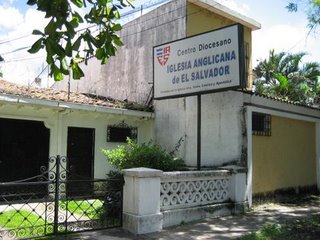 We met at the diocesan office and were given a brief tour by Fr. Ramiro Chavez, with whom I would spend much of the next day as well.
We met at the diocesan office and were given a brief tour by Fr. Ramiro Chavez, with whom I would spend much of the next day as well.The Anglican Church of El Salvador is comprised of 18 congregations and 12 clergy, two of whom are women. Along with the dioceses of Costa Rica, Guatemala, Nicaragua, and Panama, it constitutes the Province of the Anglican Church of Central America, one of 38 Provinces of the world-wide Anglican Communion.
 Fr. Tommy Dillon introduced our 11 member team to Bishop Barahona and several clergy of this diocese. We were warmly welcomed and made plans for the next day, Sunday. The three priests in our group, Fr. Tommy, Fr. Daniel, and myself would split up to visit various congregations and say mass there. I couldn't refuse such a gracious invititation, even though I've never studied a lick of Spanish! Fr. Daniel, who is fluent, provided a crash course later that evening!
Fr. Tommy Dillon introduced our 11 member team to Bishop Barahona and several clergy of this diocese. We were warmly welcomed and made plans for the next day, Sunday. The three priests in our group, Fr. Tommy, Fr. Daniel, and myself would split up to visit various congregations and say mass there. I couldn't refuse such a gracious invititation, even though I've never studied a lick of Spanish! Fr. Daniel, who is fluent, provided a crash course later that evening! Once business was concluded, Bishop Barahona and his lovely wife, Betty, hosted us for lunch at their home. It was a wonderful feast filled with laughter and conversation. We learned about the diocese's work for human rights and human dignity in El Salvador, the history of the civil war and its aftermath, and current ecumenical relations. The Bishop also provided an interesting perspective on the current challenges facing the Anglican Communion over issues of authority and human sexuality.
Once business was concluded, Bishop Barahona and his lovely wife, Betty, hosted us for lunch at their home. It was a wonderful feast filled with laughter and conversation. We learned about the diocese's work for human rights and human dignity in El Salvador, the history of the civil war and its aftermath, and current ecumenical relations. The Bishop also provided an interesting perspective on the current challenges facing the Anglican Communion over issues of authority and human sexuality.Bishop Barahona has been a strong supporter of our Presiding Bishop, Frank Griswold, and attended Bishop Gene Robinson's consecration to stand in solidarity with Bishop Griswold, even though Griswold warned him that it might cause him trouble. Barahona said, "That is for me to worry about. I have to follow my conscience." Because Bishop Robinson is openly gay, many conservative U.S. Episcopal Churches withdrew support for Mission San Lucas when they learned that Bishop Barahona attended Robinson's consecration. My parish, St. John's, and the Louisiana Integrity chapter raised money to cover the gap. It was important for us to express our gratitude to Bishop Barahona for his support of the full inclusion of all of the baptized in the Church.

Bishop Barahona declared, "I am not part of the Global South [those Anglican Primates who opposed Gene Robinson's consecration], I'm part of the Global Center that seeks to keep everyone in communion despite our differences." He also expressed strong support for our Presiding Bishop-elect, Katharine Jefferts Schori, and promised to stand by her in the upcoming meeting of the Anglican Primates.
As our group from St. John's posed with Bishop Barahona for this picture on the roof of his home, I was struck by the fact that he was surrounded by gay men and lesbians who are committed, like him, to an inclusive church that refuses to pit justice for gay and lesbian people against the relief of global human suffering. We must struggle for both within and through the Anglican Communion. We do not have to choose one or the other in order to be faithful.
Sunday, October 8, 2006
Bishop Defines Policy for Blessing Same Sex Unions
- Blessings are subject to the discretion of clergy in consultation with couples
- Careful counseling and preparation should precede the rite
- The bishop is to be informed of the blessing in advance and consulted regarding the rite, as part of the exercise of his pastoral responsibility
- The Diocesan Commission on Marriage and Blessings will identify and/or develop rites of reference for use in the diocese (this will relieve couples and clergy of the onerous and unfair task of having to reinvent the liturgical wheel for every rite)
- "The blessings of same-sex couples in our churches are celebrations of Christian love and vocation, and deserve the same expressions of joy and excitement that others enjoy." (in other words, such rites are not to be treated as a dirty secret, but as a public expression of the church's common life and ministry like any other sacramental rite)
Bishop Marc is demonstrating the kind of transparency that caused him to be elected bishop of California in the first place. This is a real step forward toward the full inclusion of lesbian and gay couples in the diocese of California, and Bishop Marc is to be commended for his leadership. It will, no doubt, result in some backlash across the wider church. Ultimately, however, it will be a gift for all Christians who care about the vocation of couples as icons of holy relationship.
It is an important next step on a journey that isn't over yet.
Friday, October 6, 2006
Interlude: Allegria
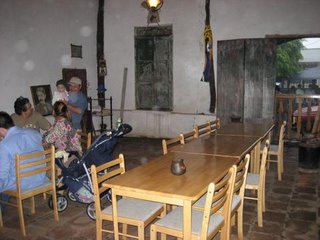
 On Friday evening, the second day of our El Salvador pilgrimage, we took a break from the sultry heat by escaping to the mountain village of Allegria, about one hour from San Miguel. The countryside is an amazingly beautiful mix of tropical forest and volcanic mountain ranges.
On Friday evening, the second day of our El Salvador pilgrimage, we took a break from the sultry heat by escaping to the mountain village of Allegria, about one hour from San Miguel. The countryside is an amazingly beautiful mix of tropical forest and volcanic mountain ranges.Caught in a magnificent thunderstorm, we took refuge in a charming cafe. Even here, one could find a latte and Internet access.
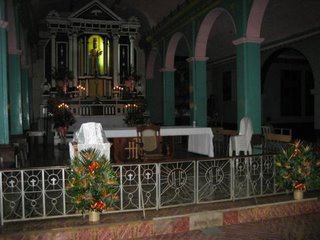
The Roman Catholic parish church in Allegria was right off the central street and was open into the evening. People wandered in and out to sit, pray, and talk together. I was struck by how much the church was integrated into the social fabric of the town. Here, poverty doesn't necessarily isolate people from community.

There must have been a festal celebration including a procession through the town, because we discovered in the church a band of angels in parade formation.
The lush natural environment and cultural pageantry provide a counterpoint to the stark poverty and simple human kindness of the people. It all served to refresh my spirit, even as it challenged me to examine my complicity in the cultural and economic hegemony of the U.S.
Thursday, October 5, 2006
Pilgrimage to El Salvador: Day Two
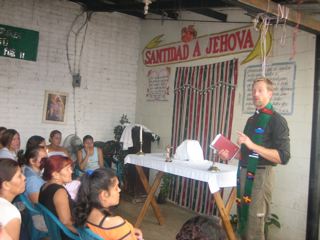 Elvira invited each of the women to join us for mass, at which Fr. Daniel Simons, a priest from St. Gregory's, San Francisco, and our translator, presided. More than 50 women attended and joined in the singing and praying with gusto. Many were visibly moved. One woman, in tears, had only been in the prison for five days. She was worried about her seven month old, whom she was now unable to nurse and didn't have any money to feed. Elvira promised to look after the child.
Elvira invited each of the women to join us for mass, at which Fr. Daniel Simons, a priest from St. Gregory's, San Francisco, and our translator, presided. More than 50 women attended and joined in the singing and praying with gusto. Many were visibly moved. One woman, in tears, had only been in the prison for five days. She was worried about her seven month old, whom she was now unable to nurse and didn't have any money to feed. Elvira promised to look after the child. Since it was Fr. Daniel's birthday, all the women wanted to give him a birthday kiss!
From the prison we went to the local public school. Located in a poor neighborhood riven with gang violence, the school was surrounded by a gated wall. More than 1,600 students attend K-8th. grade; half in the morning and half in the afternoon. The children only receive four hours of instruction each day.

Here we see a few students outside the classrooms.
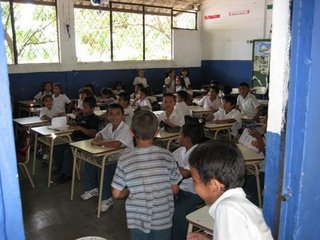
Here is a view inside the classroom, with about 40 children per teacher.
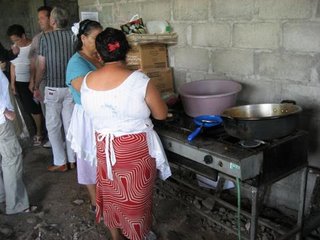
This is the school kitchen built by Mission San Lucas. The new floor has yet to be installed. Lunch is provided for the elementary school kids, but must be purchased by the middle schoolers.
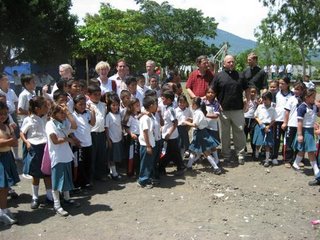
The children are curious, friendly, beautiful and energetic: just like children everywhere. And like too many children in El Salvador, these suffer from substandard housing, health care and education.
Our next stop was an orphanage run by Roman Catholic Franciscan sisters.
 The orphanage was set within well kept grounds. 50 children live here, ten to a house. Each house has a house mother. It struck me that these children were comparatively lucky: provided with a safe, clean, nurturing environment. You can see the chapel above.
The orphanage was set within well kept grounds. 50 children live here, ten to a house. Each house has a house mother. It struck me that these children were comparatively lucky: provided with a safe, clean, nurturing environment. You can see the chapel above.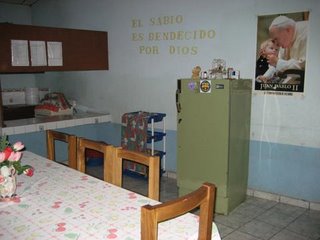
The houses are in the process of being renovated, but are still pretty spartan. Notice the poster of Pope John Paul II!
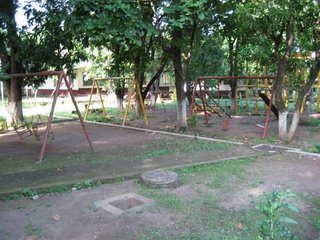
The playground could use some work. A U.S. parish refused to help Mission San Lucas install a new one, because it "wouldn't help the Anglican church." Isn't our mission to heal the world through the power of Christ's reconciling love? Who cares if it benefits the Anglican Church?
Healthy development requires safe places to play.

 "If anyone causes one of these little ones to stumble, it would be better for them to have a millstone tied around their neck and to be thrown into the sea."
"If anyone causes one of these little ones to stumble, it would be better for them to have a millstone tied around their neck and to be thrown into the sea." The faces of Christ are everywhere in El Salvador.
By the end of day two, my heart was breaking wide open.
Wednesday, October 4, 2006
Pilgrimage to El Salvador: Day One
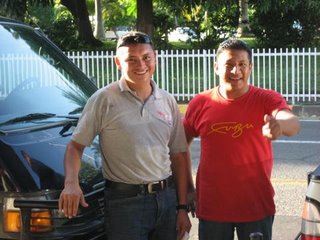 Folks from St. John's, St. Aidan's, and St. Gregory's, San Francisco made a pilgrimage to El Salvador Sept. 28 - Oct. 2. The following pictures and commentary offer a sense of the Spirit's work in this beautiful and tragic country. We were blessed by the generosity, warmth, and hospitality of the Anglican Church of El Salvador, its bishop, clergy, and people. Our special focus was on Mission San Lucas, San Miguel, a project of Cristosal in collaboration with the Diocese of El Salvador.
Folks from St. John's, St. Aidan's, and St. Gregory's, San Francisco made a pilgrimage to El Salvador Sept. 28 - Oct. 2. The following pictures and commentary offer a sense of the Spirit's work in this beautiful and tragic country. We were blessed by the generosity, warmth, and hospitality of the Anglican Church of El Salvador, its bishop, clergy, and people. Our special focus was on Mission San Lucas, San Miguel, a project of Cristosal in collaboration with the Diocese of El Salvador.When we arrived at the airport on Thursday at about 8 a.m., we were greeted by Arcelio and William. William transported our luggage by truck, and Arce transported us by van! We got to know Arce well over the course of the trip and learn a bit of his story. When he was three years old, his father was murdered by government troops during a protest demonstration outside the Metropolitan Cathedral in downtown San Salvador. His family fled his village, which was destroyed by the military. He has survived the subsequent destruction of homes my earthquake and volcano. He now lives in a house built through a microlending program sponsored by Episcopal Relief and Development.
We drove more than 2 hours to San Miguel, where we met the
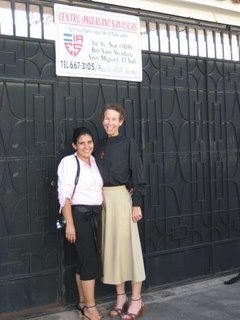 Rev. Elizabeth Evans and her assistant, Elvira, at Mission San Lucas. Elizabeth was a lay missionary from the U.S. who was ordained a priest in the Diocese of El Salvador. After checking into our hotel for lunch and a brief siesta, our first stop was a visit to the local hospital. There we met with the director of the hospital and discussed the public health issues facing the community. Maternal and child health are of particular concern.
Rev. Elizabeth Evans and her assistant, Elvira, at Mission San Lucas. Elizabeth was a lay missionary from the U.S. who was ordained a priest in the Diocese of El Salvador. After checking into our hotel for lunch and a brief siesta, our first stop was a visit to the local hospital. There we met with the director of the hospital and discussed the public health issues facing the community. Maternal and child health are of particular concern.
One of the things that Mission San Lucas has been able to provide the hospital is a mammogram machine.
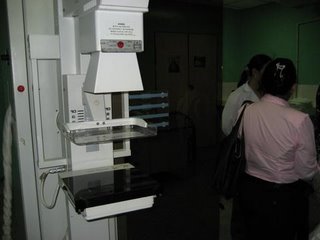 While very dedicated, the hospital staff works in a spare and dirty environment with too few resources. The pastoral care and material support of Mission San Lucas is appreciated greatly.
While very dedicated, the hospital staff works in a spare and dirty environment with too few resources. The pastoral care and material support of Mission San Lucas is appreciated greatly.While at the hospital, we delivered donated baby clothes to mothers whose premature babies were in intensive care. This is a major health problem in El Salvador, with nearly 20% of the 6,000 annual live births at this hospital being premature.
From the hospital we went to Mission San Lucas, where Rev. Elizabeth lives, teaches English to neighborhood children, and provides transitional housing for women released from the local prison. Some of the women also stay at Elvira's home.

The conertina wire on the walls surrounding Mission San Lucas is common, as gang violence is epidemic. Elizabeth has been attacked and stalked by gang members, probably due to her work in the women's prison. Here are a few pictures of the inside of her house.

This is the community room/chapel looking in toward the office and kitchen. The Mission is a two bedroom house with running water and electricity. It costs $200 per month to rent. A hot plate serves in lieu of a stove/oven.

Elizabeth demonstrates how the laundry is done by hand and then hung out to dry in the back courtyard of her middle class home (which also serves as an outdoor shower).
Our final stop of the day was a visit to Bertila's home. Bertila is a 65 year-old woman recently released from prison. She has no Social Security or other such support, and would be utterly destitute were it not for Mission San Lucas and the support of some of her neighbors. Her home is quite a contrast to Elizabeth's.
 This is Bertila's front porch. The chair is one of the few pieces of furniture left in her home after five years in prison.
This is Bertila's front porch. The chair is one of the few pieces of furniture left in her home after five years in prison.
When we arrived, Bertila was not home. Although the front door looked rather quaint, don't be deceived.

There is nothing quaint about poverty. There is no running water or electricity in this home.
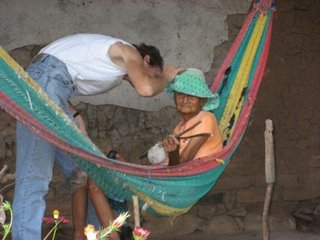
While we waited for Bertila, Rev. Elizabeth made sure that Mama, Bertila's mother, was ok. She was hanging out on the front porch.

When Bertila arrived, she greeted us warmly and was very touched by our visit and grateful for the little bit of food and friendship we offered.

However, Bertila was dismayed to discover that a dog had killed and was nibbling on one of her chickens. She wasn't planning on chicken for dinner, but, oh well!
Needless to say, I didn't have chicken for dinner that evening!
By the time we left Bertila's, it was dusk. Time for dinner and a good night's sleep after a red eye flight and a full day of travel and touring. And this was just day one!